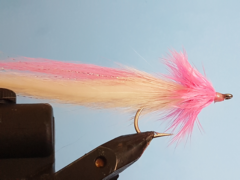Posts Tagged ‘GT’s’
{{start}}
{{end}}

{{+1}}Clouser – synthetic MKII{{-1}}
{{start}}
This is my favourite version of the clouser for use when targeting fish holding deep and is tied with H2O slinky fibre which makes the fly present as slightly translucent.{{end}}

{{+1}}Candy – pelagic{{-1}}
{{start}}
Matching the hatch is the key to catching pelagics such as queenfish, tuna, Australian salmon and herring on fly. These unweighted flies are like candy to pelagic fish because they closely match the form and function of a lot of naturals they are targeting. In smaller sizes, particularly in pink, they are a handy fly for targeting flathead and bream in estuary waters.{{end}}

{{+1}}Trailing hook fly – for use with articulated popper head{{-1}}
{{start}}
This fly is designed as a simple yet effective fly to be fished behind my articulated popper heads.{{end}}
















